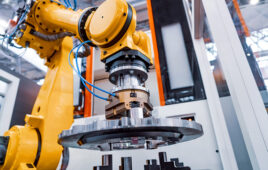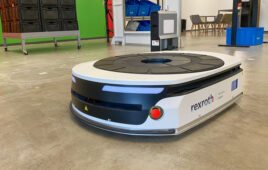 An automatic guided vehicle (AGV) is a type of unmanned guided vehicle (UGV) that moves throughout a facility by following a set of predetermined paths. An AGV is NOT a sub-class of mobile robot. AGVs are the predecessors to mobile robots and have been in operation since the 1950’s, however, they still have a variety of uses within a modern manufacturing or warehouse environment.
An automatic guided vehicle (AGV) is a type of unmanned guided vehicle (UGV) that moves throughout a facility by following a set of predetermined paths. An AGV is NOT a sub-class of mobile robot. AGVs are the predecessors to mobile robots and have been in operation since the 1950’s, however, they still have a variety of uses within a modern manufacturing or warehouse environment.
An autonomous mobile robot (AMR) is a different class of UGV that has more capabilities than an AGV. AMRs are capable of free-movement and real-time path planning that enables them to collaborate in material handling tasks with humans.
 Register now for the 2024 Robotics Summit.
Register now for the 2024 Robotics Summit.
In addition, while AGVs are all wheeled vehicles, AMRs come in a variety of locomotion configurations. This includes not only wheeled vehicles, but also tracked vehicles, bipedal robots, quadruped robots, and multi-legged robots.

A train vs a taxi
The best analogy for understanding one of the primary differences between an AGV and an AMR is that an AGV is like a railroad train engine, constrained only to operate on its train tracks. An AMR, on the other hand, is like a taxi, able to freely move between any two points, and replan a route when the traffic is too dense.
The term Industrial Mobile Robot (IMR) was introduced in the recent safety standard ANSI/RIA R15.08. Although it was widely debated by industry experts and voted on within the new standard, IMR has not reached broad usage as of the writing of this article, but may emerge to replace the term AMR in future years.
In addition to Unmanned Guided Vehicle (UGV), there are also Unmanned Aerial Vehicles (drones), and Unmanned Marine Vehicles (autonomous boats/ships).
Similarities between AGVs and AMRs:
- Both can be used to move material from one point to another within a facility.
- Avoid collisions with objects that might come into their path.
- Can operate collaboratively and safely with humans within their workspace (or intended paths).
- Carry cargo between 2 kg and 1500 kg.
Differences between AGVs and AMRs:
AGV
- Simpler control system and sensors than an AMR. In some cases, AGVs are a less expensive solution than an AMR.
- Primarily path follow some type of fixed infrastructure such as magnetic tape/wire, painted lines, QR code stickers or laser targets.
- Remain within the confines of their operations lanes/paths.
- Can be designed to carry extreme payloads, such as locomotive engines and airplane fuselages.
- AGV’s may become “stuck” if they come across an object in its intended path. This often requires the help of an operator to move the object and restart the AGV on its mission.
- Work best in well defined conditions and applications such as material handling or WIP in a manufacturing facility.
AMR
- Freely navigate their operational space.
- Navigate a path between a starting point and a destination.
- Can operate outside of a building.
- Can follow humans around a facility in a “follow me” application.
- Not only avoid obstacles, but actively navigate around obstacles to continue towards a mission goal.
- Can become “lost” if it can’t recognize its surroundings. This often occurs when crossing large expanses of floor space without any recognizable infrastructure (e.g. airplane hanger or large meeting space). AMRs can also become lost in repetitive enronments, such as similar looking warehouse aisles or in chaotic work areas such as a loading dock. AMR manufacturers have a variety of methods to keep their machines “localized”.
- Work best in applications in unstructured environments such as security, deliveries, person to goods and goods to person intralogistics.
Final notes and takeaways
Unfortunately, some manufacturers of AMRs have adopted the term AGV to describe their autonomous machines. This is unfortunate, as it causes confusion within the market. As you learned above, the primary requirement of an AGV is that it needs some infrastructure to be place within the vehicles workspace to enable navigation. AGVs also can not navigate around an obstacle.











Tell Us What You Think!
You must be logged in to post a comment.